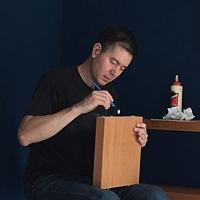Share your craft projects
Make new craft buddies
Ask craft questions
Blog your craft journey

Ron Stewart
865 posts
and
24 followers
in about 3 years
in about 3 years
More from Ron Stewart
Mini Tetrahedral Tensegrity Table Details #8: Disk Details--Attaching the Outer Support Wires
This is
part 8
in a
10 part
series:
Mini Tetrahedral Tensegrity Table Details
...
-
Making the Top and Bottom Disks
-
Disk Details--Attaching the Outer Support Wires
-
Finishing the Disks and Attaching the Pyramids
...
- Making the Top and Bottom Disks
- Disk Details--Attaching the Outer Support Wires
- Finishing the Disks and Attaching the Pyramids
Before I could apply finish to the disks and attach the pyramids, I had to iron out the details of how to attach the three outer support wires.
The video Tensegrity Explained shows a kit manufactured by Kontax/Stirling Engineering. It uses an ingenious method for attaching and adjusting the support wires. The table's top disc has slots near the edges. Bolts entering the edge go through loops in the wires to secure them. The underside of the table's bottom disk has channels that hold small sleds that are also attached to threaded bolts from the edges. The bolts allow the kit builder to attach the wires loosely, then adjust their tension.
I was hoping to avoid the complexity of the hidden tensioning sleds, but I liked the slot/loop idea. The only thing I didn't like about it is that the slots went all the way through the tabletop and were visible from above. Instead of through-slots, I decided to drill pockets on the undersides of the top and bottom disks and use 16-gauge brad nails to secure the wire loops. (As small as the wire crimp tubes were, I thought they would mostly fit inside the pockets and not be too visible.) If I made all three wires the same (correct) length, I thought the table would be stable, and I wouldn't need any tensioning mechanism.
I created the pockets with a 1/4" diameter Forstner bit. The pockets are approximately 1/4" deep (slightly more than half the disks' thickness to leave room for the nail and wire loop). To make sure the pockets in the top and bottom disks aligned perfectly, I drilled 1/4" through-holes in the disk template I had created earlier. I used a finished pyramid to locate the holes, and I also drew layout lines for the pyramids on the template. I'd need them later to help attach the pyramids to the disks.
The video Tensegrity Explained shows a kit manufactured by Kontax/Stirling Engineering. It uses an ingenious method for attaching and adjusting the support wires. The table's top disc has slots near the edges. Bolts entering the edge go through loops in the wires to secure them. The underside of the table's bottom disk has channels that hold small sleds that are also attached to threaded bolts from the edges. The bolts allow the kit builder to attach the wires loosely, then adjust their tension.
I was hoping to avoid the complexity of the hidden tensioning sleds, but I liked the slot/loop idea. The only thing I didn't like about it is that the slots went all the way through the tabletop and were visible from above. Instead of through-slots, I decided to drill pockets on the undersides of the top and bottom disks and use 16-gauge brad nails to secure the wire loops. (As small as the wire crimp tubes were, I thought they would mostly fit inside the pockets and not be too visible.) If I made all three wires the same (correct) length, I thought the table would be stable, and I wouldn't need any tensioning mechanism.
I created the pockets with a 1/4" diameter Forstner bit. The pockets are approximately 1/4" deep (slightly more than half the disks' thickness to leave room for the nail and wire loop). To make sure the pockets in the top and bottom disks aligned perfectly, I drilled 1/4" through-holes in the disk template I had created earlier. I used a finished pyramid to locate the holes, and I also drew layout lines for the pyramids on the template. I'd need them later to help attach the pyramids to the disks.

Then I used the template and my drill press to create the pockets in the disks.

Because the pockets in the bottom disk were on its underside, I needed to drill small through-holes for the wires. I used the smallest bit I have (1/16" diameter).

Then I had to drill the perpendicular holes from the disks' edges through the pockets for the brad nails. I used a combination square to mark the hole positions and used the same 1/16" drill bit. I clamped the disks to a thick block of scrap to hold them vertically in the press.

When I test fit the brad nails, they were slightly snug. I didn't want them to split the disks, so I enlarged the holes with a 5/64" bit. I had already stowed my drill press, so I did it by hand.

A quick test showed that the nails were close enough to the centers of the pocket to leave room for the wire loops.

Now I was ready to finish the disks and attach the pyramids.








